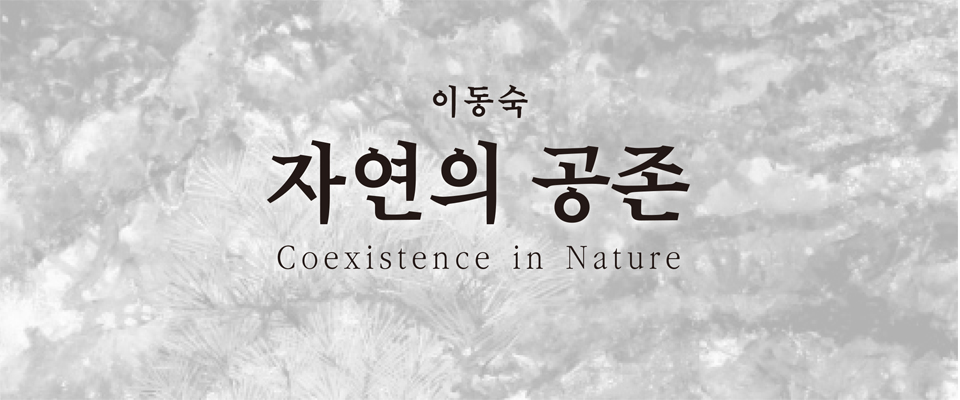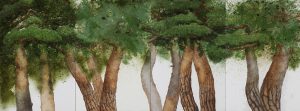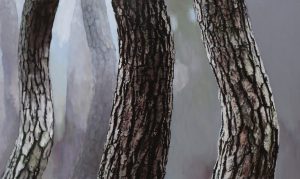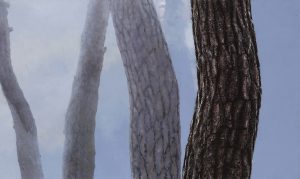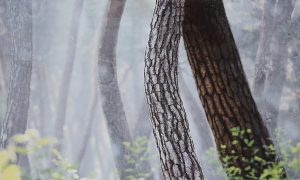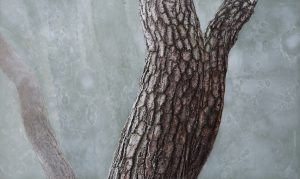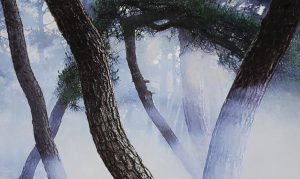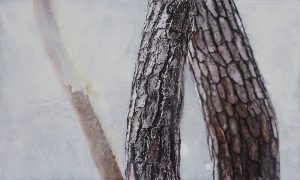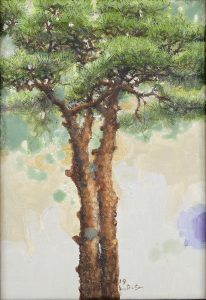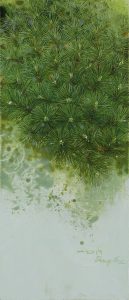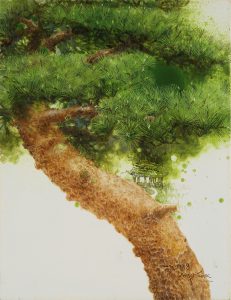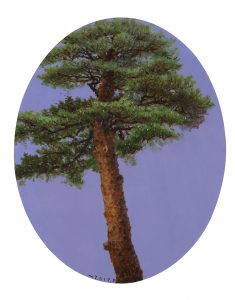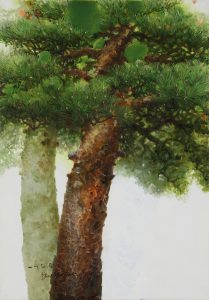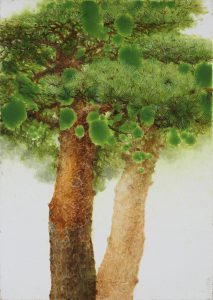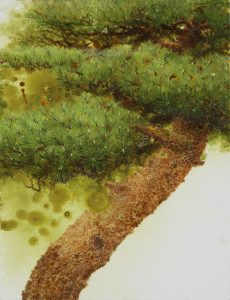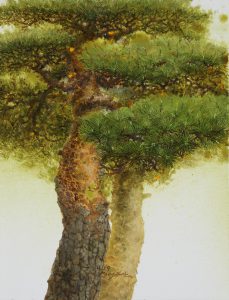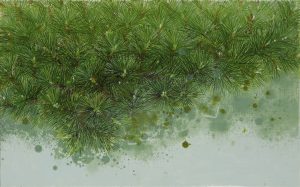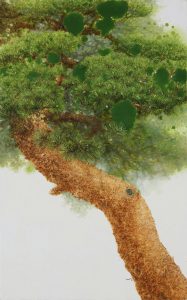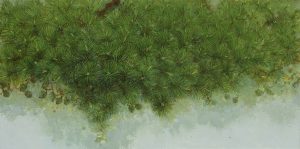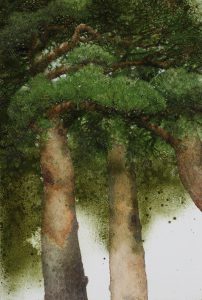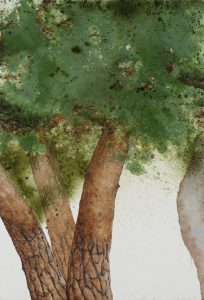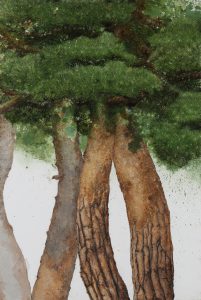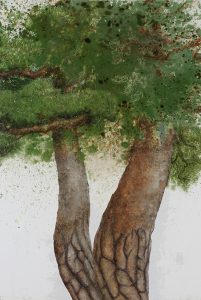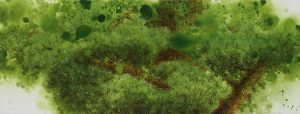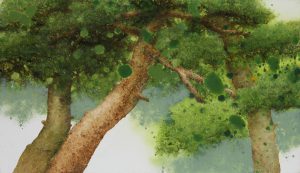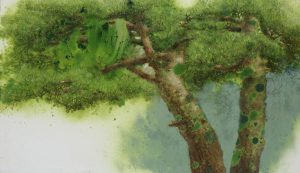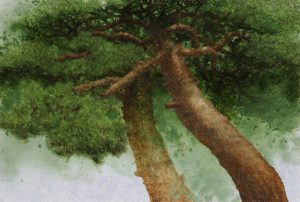이동숙 개인전 자연의 공존
이동숙
2019 09/11 – 09/16
본 전시장 (1F) 특별 전시장 (B1)
자연의 공존
박영택 (경기대교수, 미술평론가)
이동숙은 소나무를 소재로 해서 이를 구상화법에 의지해 그리고 있다. 그 이력이 꽤나 깊다. 이른바 소나무는 한국 국토의 자연미를 상징하는 한편 한국적인 미와 멋의 한 원천으로 여겨지고 있다. 그리고 그같은 생각은 이곳 한국작가들에게 무척 보편적인 상식으로 굳어 있는 편이다. 백자나 오방색처럼 말이다. 전통이나 정체성, 한국적인 미의식을 거론할 때마다 빈번하게 호명되는 그러한 것들이 한국미의 본질을 종합적으로 함축하고 있다는 생각은 분명 의미가 있기도 하지만 동시에 다소 위태롭기도 하다. 전통을 박제화하거나 소재주의로 국한시킬 수 있는 아쉬움 내지 작업의 알리바이로만 작동할 수 있기에 그렇다.
이동숙이 그리는 소나무는 앞서 언급한 상징성의 무게감보다는 소나무 자체를 조형적으로, 회화적 대상으로 취급하는데 더 관심이 있어보인다. 대부분 소나무 군락지(숲)에서 부분적으로 절취해 들어간 시선에 의해 포착된 화면은 전적으로 수직으로 오르는, 독특한 휘어짐과 굴곡의 자태를 거느린 소나무의 굵은 몸통과 나무 등걸의 특이한 질감, 그리고 다채로운 녹색과 날카롭고 예리하며 촘촘한 선들이 화면 상단을 지붕처럼 채우고 있을 뿐이다. 화면을 수평으로 펼쳐놓았기에 소나무가 좌우로 연장되며 펼쳐지며 이어지고 있다는 느낌이 들고 아울러 화면의 위아래에 꽉 채워 그려놓았기에 보는 이들은 자신들이 흡사 소나무 숲 안에 들어와 있다는 착각을 받을 수 있다. 한편 단독의 화면보다는 통상 몇 개의 화면을 잇대어 놓아 흡사 병풍과도 같은 프레임 구성을 이루는 것 역시 그러한 의도를 반영하기 위한 장치로 보인다. 전체적으로 다소 납작해진 공간위로 소나무 자체만이 중점적으로 자기 존재를 웅장하게 펼쳐낸다.
캔버스에 유화로 그렸지만 유채 물감 특유의 점성이나 질감처리는 약화시키고 대신 수채화처럼 흡수, 번짐의 효과는 극대화되고 있다. 그 위에 부분적으로 물감을 덧칠하고 묘사를 집중한 부분과 약간의 발림으로만 놓아둔 부분이 극명한 대조를 이루는 편이다. 부분적으로 캔버스의 바탕 면을 그대로 노출시켜 이른바 동양화의 여백과도 같은 효과로 남겨두고 있는데 이는 캔버스의 평면성을 인식시키고 드러내는 한편 주변 풍경을 삭제하고 오로지 소나무만을 주목시키려는 의도일 수도 있다. 아울러 유채 물감을 수채화물감처럼 다루는 작가 특유의 효과로 인해 그 같은 그려지지 않은 바탕, 즉 물감이 번지고 스미는 효과가 이루어지는 화면이 불가피하게 요구된다고 본다. 따라서 상당히 특이한 유화의 방법론을 접하고 있다. 이런 기법은 본인이 소나무에서 받은 인상과 그 맛을 효과적으로 표현하는데 적합하다고 여겼거나 또는 기존 구상화법의 다소 익숙하고 정형화된 기법에서 벗어나려는 한 시도로 보인다.
따라서 화면은 채움과 비움, 불투명과 투명함. 묘사된 부분과 여백, 끈끈한 질감과 휘발성의 번짐 등 다소 이질적인 요소들이 혼재·절충되어 있고 이것이 한편에서는 흥미롭고 다른 측면에서는 다소 매우 얇은 효과로 머물 수 있다는 느낌도 준다. 한편 화면 상단에 중후하게 착색된 녹색의 싱싱하고 깊은 색채의 맛과 소나무 줄기의 힘차게 뻗는 선은 회화적인 풍요로움을 거느린다.
근작에서 새롭게 그려지는 또 다른 종류의 소나무는 이전 그림과는 달리 오로지 나무의 몸통만을 화면에 수직으로 분할하듯 그려넣고 주변은 단호하게 지워나간 그림이다. 사진과 유사하게 그려진 극사실주의 회화에 속하는 그림으로 대상의 실재감, 환영감을 고조시키는 편이다. 그것은 사진과 회화가 겹쳐있는 지점에서 풀려나오며 사진의 효과를 응용한 회화다. 이런 유형의 그림은 일반적인 편이다. 이 근작은 무엇보다도 카메라의 메커니즘(기계론)이 잡아낸 시선이자 그 렌즈의 효과로 인해 극단적인 원근의 효과가 강조된 구도를 차용한 그림이기에 그림의 중심에 자리한 전경의 사물에 선명하게 초점이 맞춰져 있고 그 뒤는 전체적으로 뭉개져 있다. 따라서 근접 시각으로 포착된 나무의 표면은 정교하게 묘사되어 그 질감이 두드러지게 자리하고 있다면 그 뒤쪽의 풍경은 극단적인 거리감의 강조로 죄다 사라져버린다. 특히 작가는 전경에 자리한 나무의 뒤편, 저 안쪽에 자리한 숲을 다소 신비스럽고 환상적인 분위기로, 빛으로 충만한 공간으로 연출하고자 했다. 이 강한 대비감 역시 앞서 언급한 소나무 그림과 다분히 유사한 차원에서 그려진 부분과 여백/지워진 부분, 정밀한 재현과 물감의 물성이나 질료 자체를 추상적으로 다루는 부분, 밝음과 어두움 등의 차이 속에서 구현되고 있다. 반면 이 그림에서는 명암의 대비 아래 진한 어둠 속에 자리한 나무의 표면 처리에 풍부한 색감으로 인한 회화성, 촉각성이 요구된다.
작가의 소나무를 보면 대부분 두 개씩 서로 기대어 있거나 짝을 이루어 직립한다. 나로서는 이 부분이 작가 작업의 핵심적인 주제인 듯싶다. 결국 작가는 산/숲에서 소나무를 비롯한 일련의 나무들을 바라보면서 그것들끼리의 공생과 공존의 현장을 상당히 인상적으로 깨닫게 되었던 것 같다. 자연생태계는 거대한 먹이사슬로 연결되어 있기도 하고 유기적으로 긴밀한 공생의 관계망 속에서 서로 기대어 있다. 어쩌면 각박하고 치열한 경쟁 구도와 비정한 현실세계의 인간관계가 노정하는 생존경쟁의 그물망에서 접하기 어려운 조화로운 공생과 조화의 장면이라고 여겨지는 자연의 세계, 나무들이 보여주는 그 세계를 그림으로 재구성해서 다시 보여주고자 한다. 나무들끼리의 조화로운 공존의 삶을 이 일련의 소나무 그림을 통해 은유적으로 환기시켜보려는 것이 작가의 의도라는 생각이다.
Coexistence in Nature
Park Young-taek (Professor at Kyonggi University and art critic)
Lee Dong-sook uses pine trees as her material and relies on figurativism to paint these. In fact, the history for this runs quitedeep. While a pine tree symbolizes natural beauty in Korea, it is also regarded as a source of Korean beauty and taste. This thought is inscribed quite universally in the minds of Korean artists, similar to the thoughts about Korea’s white porcelain orobangsaek, which is the traditional Korean color spectrum. The belief that these things encapsulate the essence of Korean beauty and are often referred to whenever we talk about the country’s tradition, identity, or aesthetic consciousness, may be meaningful
but also dangerous at the same time. It may have an adverse impact on the beliefs about the traditions of Korea, may reduce it to simply material, or otherwise function as an alibi for one’s work.
In her pine tree paintings, Lee seems to be more interested in approaching it as the object for plastic or painting art than its symbolic heaviness, which is described above. These paintings capture the view that cuts through partially from a pine tree cluster or forest, the thick trunk of pine trees that rises vertically with unique bends and curves, the stump’s exceptional rich green texture, and sharp, pointed, and tightly packed lines that fill the top of the canvas like a roof.
As the paintings are unfolded horizontally, it makes us feel that the pine trees are extending and they continue to the left and right. As the top and bottom of her paintings are fully packed, the audience may find themselves under the impression that they are standing right in the middle of the pine forest. Meanwhile, the frame is like a folding screen created by linking together multiple paintings instead of a single painting, and this also seems to be a device designed to reflect Lee’s intention. The space above is rather flat overall, while the pine trees stretch out and portray their own majestic presence.
Although the trees were oil-painted on canvas, the artist weakens the paint’s viscosity or texture but maximizes the effects of absorbing and blurring like a watercolor painting. The part that is partially painted over and focused on the description is a sharp contrast with the one that is slightly rubbed. By partially exposing the base of the canvas, which is without any paint, her paintings produce the same effect as the empty space seen in some Eastern paintings. This could have been an attempt to recognize and reveal the flatness of the canvas by removing the surrounding landscape to make us solely focus on the trees. In addition, the unique effect from the artist, who uses oil paint like watercolor paint, inevitably require this unpainted background where the paint is blurred and faded. Hence, Lee deploys a rather unique oil painting method. The artist may have regarded this method as more fitting to effectively represent the impression and taste that she gets from the pine trees, or the method seems to be an attempt to deviate from a more familiar and formulaic one that is seen in traditional figurativism.
The paintings are blended and harmonized with somewhat contrasting elements such as filled and empty spaces, nontransparent and transparent, described and non-described, and sticky texture and volatile blurring, which look interesting on one hand but give a feeling that it may remain a very shallow effect on the other hand.
Meanwhile, lively and deep green colors used at the top of the canvas and strongly stretched-out lines, which represent pine tree needles, enrich the paintings.
Her latest painting depicts only the tree’s trunk unlike her previous paintings. This gives the impression of splitting the painting vertically while boldly removing the surroundings. This painting, which is painted in a manner that is similar to a photograph, depicting extreme realism, elevates the object’s sense of presence and illusion. It unfolds from an intersection of painting and photography, and the painting uses the effects of photography. This type of painting tends to be typical. Most of all, the latest work borrows the composition where the pine tree is captured by the view of the camera’s mechanism and extreme perspective is highlighted with the camera lens effect. Hence, the focus is clearly on the object in the foreground, at the center of the painting, while the background is blurred. The surface of the tree which seems to be captured up close is described in detail, the texture is positioned noticeably, whereas the landscape behind the tree seems to vanish due to the painting’s extreme emphasis on distance. In particular, the artist tries to represent that the forest is positioned further away behind the tree by creating a mysterious and fascinating atmosphere as well as by representing space that is filled with light. This strong variation is represented through contrasting differences such as painted and empty spaces, delicate representation and abstraction with paint’s physical properties or materials, light and dark, just like her aforementioned pine tree paintings. Nevertheless, this painting represents painterly and haptic qualities due to the rich colors on the tree’s surface that are placed in deep darkness amid the tonal contrast.
If you look at the pine trees painted by the artist, two of them seem to lean on each other or are represented as a pair that is standing up straight. To me, this seems to be a key theme in the artist’s work. In the end, the artist seems to have had the realization, while looking at pine trees and other trees in the mountains or forests, that different trees live and exist together quite impressively. The natural ecosystem is connected by a huge food change, while everyone leans on each other in an organic network of coexistence. Maybe, she reconstructs and shows the world what the trees reveal in her paintings, the coexistence and harmonization of nature that we find difficult to see because of the framework of cut-throat and fierce competition and the net of competition for survival where unsympathetic human relationships are laid bare in reality. My thought is that what the artist intends to metaphorically convey the harmonious and coexistent life of trees in her series of pine tree paintings.
